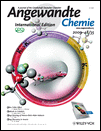Microfluidic Formation of Monodisperse, Cell-Sized, and Unilamellar Vesicles†
We thank Dr. Andrew S. Utada for helpful discussions. This work was partly supported by Grants-in-Aid for Scientific Research on Priority Areas (innovative nanoscience) from Ministry of Education, Culture, Sports, Science, and Technology Japan and Kanagawa Academy of Science and Technology (KAST) (Japan).
Graphical Abstract
Gently down the stream: A microfluidic technique uses a continuous fluid stream to generate monodisperse unilamellar phospholipid vesicles from a single bilayer (see picture). Since the vesicles are robust and efficiently encapsulate high concentrations of various molecules, they are useful as delivery vehicles and as model cellular systems.





